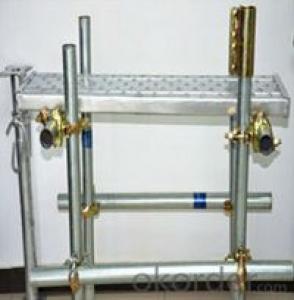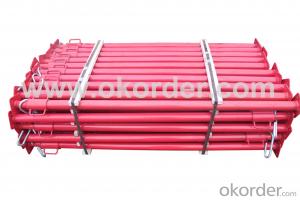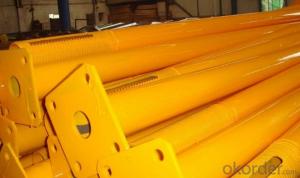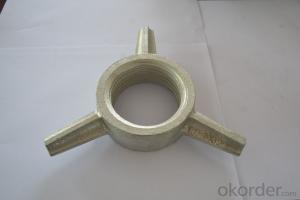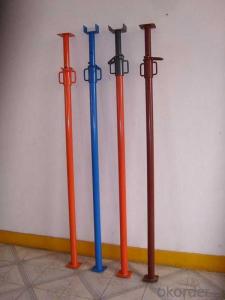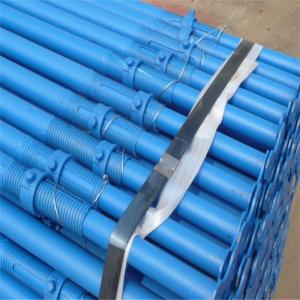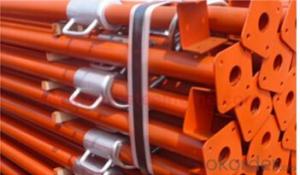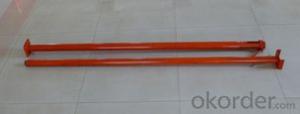scaffolding with galvanized surface
- Loading Port:
- China Main Port
- Payment Terms:
- TT OR LC
- Min Order Qty:
- -
- Supply Capability:
- -
OKorder Service Pledge
OKorder Financial Service
You Might Also Like
Quick Details
| Model Number: | |||||
| type: | useage: | surface treatment: | |||
| OD: | Thickness: | payment terms: | |||
| lead time: | MOQ: | application: | |||
| package: |
Packaging & Delivery
| Packaging Detail: | standard packaging or according to the customers' requirements for scaffolding |
| Delivery Detail: | within 15 days for scaffolding |
Specifications
scaffolding
1.construction material steel pipes&beams scaffolding
2.High quality construction steel scaffolding
scaffolding
scaffolding with galvanized
Introduction
We are manufacturer specialized in scaffolding&formwork materials. Our best-selling products areslab formwork system(Patent No:ZL200420091863.6). It's adjustable system, very time-saving and labor-saving.
They replaced timbers,steel pipe&couplers.Wasting of timbers and couplers can be avoided. Moreover, this system can quicken construction period and improve quality of concrete casting.
2. Product Details and Show
a. Main Beam & Sub Beam ( replace H20 wood beam and aluminium I beam)
- Q:Can steel props be used in the construction of underground metro systems?
- Indeed, underground metro systems can utilize steel props in their construction. These props are frequently employed in construction projects to offer temporary support and stabilization to structures. When it comes to underground metro systems, steel props can serve as support for the tunnel walls and ceilings during excavation and construction. Steel props are favored in underground construction due to their robustness, longevity, and ability to bear heavy loads. They have the capacity to withstand the immense pressures and weights exerted by the surrounding soil and rock, ensuring the stability and safety of the underground structures. Moreover, steel props are adaptable and adjustable, allowing for customization to suit various tunnel dimensions and specifications. They can be easily installed and removed as the construction progresses, making them a cost-effective solution for temporary support. Additionally, steel props can be combined with other construction techniques and materials, such as shotcrete and steel beams, to enhance the overall stability and strength of the underground metro system. All in all, steel props are a dependable and widely employed choice in the construction of underground metro systems. They provide the necessary support and stability required for safe and efficient construction.
- Q:What are the typical costs associated with renting steel props?
- The rental fees for steel props can differ based on several factors, including the rental duration, the quantity of props required, and the location. On average, the cost per week for each prop can range from $2 to $6. Furthermore, there might be extra charges for delivery and pickup, as well as any damages incurred during the rental period. Some rental companies may ask for a security deposit or insurance coverage to safeguard against potential damages or loss of the props. It is crucial to note that the rental cost of steel props can also fluctuate depending on market demand and the specific supplier. Therefore, it is advisable to contact various rental companies to obtain accurate and current pricing information that aligns with your specific project needs.
- Q:Can steel props be used in wastewater treatment plant construction?
- Indeed, the utilization of steel props is applicable in the construction of wastewater treatment plants. These props are frequently employed to bolster formwork and scaffolding during construction endeavors, providing both stability and the capacity to bear heavy loads. In the context of wastewater treatment plant construction, steel props can be utilized to support weighty machinery, tank walls, and other structures. The durability and strength inherent in steel render it an appropriate material for enduring the harsh and corrosive conditions prevalent in wastewater treatment facilities. Furthermore, steel props can be easily adjusted and tailored to accommodate the diverse heights and angles necessitated throughout the construction process. All things considered, steel props are a pragmatic and dependable choice for supporting the construction of wastewater treatment plants.
- Q:Can steel props be used for temporary support during equipment installation?
- Yes, steel props can be used for temporary support during equipment installation. Steel props are strong and durable, making them suitable for providing temporary support and stability during the installation process.
- Q:Can steel props be used for shoring or formwork support?
- Yes, steel props can be used for shoring or formwork support. Steel props, also known as adjustable props or acrow props, are commonly used in construction to provide temporary support to structures or formwork during the construction process. They are typically made of steel and have an adjustable height feature, allowing them to be extended or retracted to the desired length. Steel props are versatile and can be used in various shoring or formwork applications. They are often used to support horizontal or vertical loads, such as supporting slabs, beams, or walls during construction or renovation projects. They can also be used to provide temporary support to formwork systems, ensuring proper alignment and stability during the pouring and curing of concrete. The adjustable feature of steel props makes them suitable for different construction scenarios, as they can be easily adjusted to the required height and secured in place. This flexibility allows for efficient installation and removal, minimizing downtime and maximizing productivity on the construction site. Furthermore, steel props are known for their strength and durability, as they are made of high-quality steel materials. This ensures that they can withstand the heavy loads and forces exerted during construction activities. They are designed to provide reliable support and stability, enhancing the safety and integrity of the structure or formwork system. In conclusion, steel props are indeed suitable for shoring or formwork support. Their adjustable height feature, strength, and durability make them an ideal choice for providing temporary support and stability to structures or formwork systems during the construction process.
- Q:Can steel props be used in supporting heavy machinery during installation?
- Yes, steel props can be used in supporting heavy machinery during installation. Steel props, also known as adjustable steel props or steel shoring props, are commonly used in construction and engineering industries to provide temporary support and stability. They are designed to withstand heavy loads and can be adjusted to the required height. When installing heavy machinery, it is crucial to ensure proper support to prevent any accidents or damage. Steel props offer a reliable solution as they are made from high-quality steel, providing strength and durability. They can bear significant weight and distribute it evenly to provide a stable base for the machinery. Additionally, steel props are adjustable, allowing for precise height adjustments as per the machinery's requirements. This adjustability makes it easier to align the machinery and ensure proper installation. However, it is important to consider the specific requirements and specifications of the machinery before using steel props. The weight, dimensions, and center of gravity of the machinery should be thoroughly assessed to determine the number and positioning of the props required. Additionally, it is recommended to consult with a structural engineer or an expert in heavy machinery installation to ensure the safety and effectiveness of using steel props in this specific application. Overall, steel props can be a suitable choice for supporting heavy machinery during installation due to their strength, adjustability, and stability.
- Q:How do you prevent steel props from sinking in sandy soil?
- There are several techniques available to prevent steel props from sinking in sandy soil. These methods include: 1. Enhancing the surface area: Improving weight distribution and reducing sinking can be achieved by using a larger base plate or spreading the load over a wider area. Attaching a larger plate or using a timber soleplate under the steel prop can help achieve this. 2. Utilizing load-bearing plates: Load-bearing plates, also known as soleplates, can distribute the weight over a larger area. These plates, typically made of steel or timber, can be attached to the bottom of the steel prop, spreading the load and preventing sinking. 3. Adding reinforcements: Enhancing the stability of the soil around the steel prop can be done by installing steel or timber stakes or using geotextiles or geogrids to strengthen the soil. These reinforcements prevent the soil from giving way under the weight of the prop. 4. Installing ground anchors: Ground anchors provide additional support and prevent sinking. Made of steel, these anchors are driven deep into the ground. Attaching the steel prop to these anchors transfers the load to more stable soil layers, minimizing sinking risks. 5. Moistening the soil: Increasing the cohesion and density of sandy soil can make it more resistant to sinking. Regularly watering the area around the steel props can compact the soil, reducing the chances of sinking. 6. Seeking professional guidance: When facing challenging sandy soil conditions, it is advisable to consult with a structural engineer or geotechnical expert. They can assess the site, recommend suitable solutions, and provide effective guidance for preventing steel props from sinking. It is important to recognize that the choice of technique will depend on specific soil conditions, load requirements, and project duration. Therefore, evaluating the site and consulting with experts is crucial to determine the most appropriate measures for preventing steel props from sinking in sandy soil.
- Q:How do you prevent overloading of steel props?
- To prevent overloading of steel props, there are several steps that can be taken: 1. Determine the load capacity: It is crucial to know the maximum load capacity of the steel props. This information can usually be obtained from the manufacturer or supplier. It is important not to exceed this load limit to prevent overloading. 2. Conduct proper calculations: Before using steel props, it is essential to perform accurate calculations to determine the required number of props and their spacing. This calculation should take into account the weight and distribution of the load, as well as any additional factors such as wind or vibration. 3. Regular inspections: Regular inspections of the steel props are necessary to ensure their integrity and reliability. Look for any signs of damage, such as cracks or deformations, that may compromise their load-bearing capacity. If any issues are detected, the props should be immediately replaced or repaired. 4. Proper placement and alignment: When installing steel props, ensure that they are placed on a solid and stable surface that can support the load. It is important to properly align the props both vertically and horizontally to ensure uniform weight distribution. 5. Adequate bracing and support: Depending on the nature of the load and the height or length of the structure being supported, additional bracing or support may be required. This can help distribute the load evenly and prevent overloading of individual props. 6. Regular monitoring: During the period of use, it is essential to monitor the steel props regularly to ensure that the load is not exceeding their capacity. This can be done by using load monitoring devices or by periodically checking the props for any signs of stress or strain. 7. Proper training and supervision: It is crucial to ensure that the personnel responsible for installing and using steel props are properly trained and supervised. They should have a good understanding of the load limits, calculation methods, and safety precautions to prevent overloading. By following these preventive measures, the risk of overloading steel props can be significantly reduced, ensuring the safety and stability of the supported structure.
- Q:Are steel props suitable for supporting heavy loads?
- Yes, steel props are suitable for supporting heavy loads. Steel props are adjustable steel columns that are used to support heavy loads in construction projects. They are designed to provide temporary support to structures such as beams, slabs, and formwork during construction or renovation work. Steel props are made from high-quality steel, which gives them excellent strength, durability, and load-bearing capacity. They are capable of supporting heavy loads and can be easily adjusted to the desired height and angle. Additionally, steel props have a wide base plate at the bottom, which provides stability and prevents sinking or tilting under heavy loads. Overall, steel props are a reliable and effective choice for supporting heavy loads in construction projects.
- Q:Can steel props be used in extreme weather conditions?
- Indeed, extreme weather conditions can accommodate the use of steel props. Steel, renowned for its robustness and longevity, proves to be an appropriate material for diverse purposes, notably aiding structures in the face of adverse weather conditions. In the realm of construction projects, steel props frequently find themselves employed to furnish provisional support for walls, floors, and ceilings during renovation or building endeavors. These props are specially designed to endure substantial loads and unfavorable circumstances, such as extreme temperatures, powerful winds, and torrential rain. Nevertheless, it remains imperative to diligently maintain and regularly inspect these steel props for any indications of impairment or corrosion, given that these factors can hamper their performance in the midst of inclement weather.
1. Manufacturer Overview |
|
|---|---|
| Location | |
| Year Established | |
| Annual Output Value | |
| Main Markets | |
| Company Certifications | |
2. Manufacturer Certificates |
|
|---|---|
| a) Certification Name | |
| Range | |
| Reference | |
| Validity Period | |
3. Manufacturer Capability |
|
|---|---|
| a)Trade Capacity | |
| Nearest Port | |
| Export Percentage | |
| No.of Employees in Trade Department | |
| Language Spoken: | |
| b)Factory Information | |
| Factory Size: | |
| No. of Production Lines | |
| Contract Manufacturing | |
| Product Price Range | |
Send your message to us
scaffolding with galvanized surface
- Loading Port:
- China Main Port
- Payment Terms:
- TT OR LC
- Min Order Qty:
- -
- Supply Capability:
- -
OKorder Service Pledge
OKorder Financial Service
Similar products
New products
Hot products
